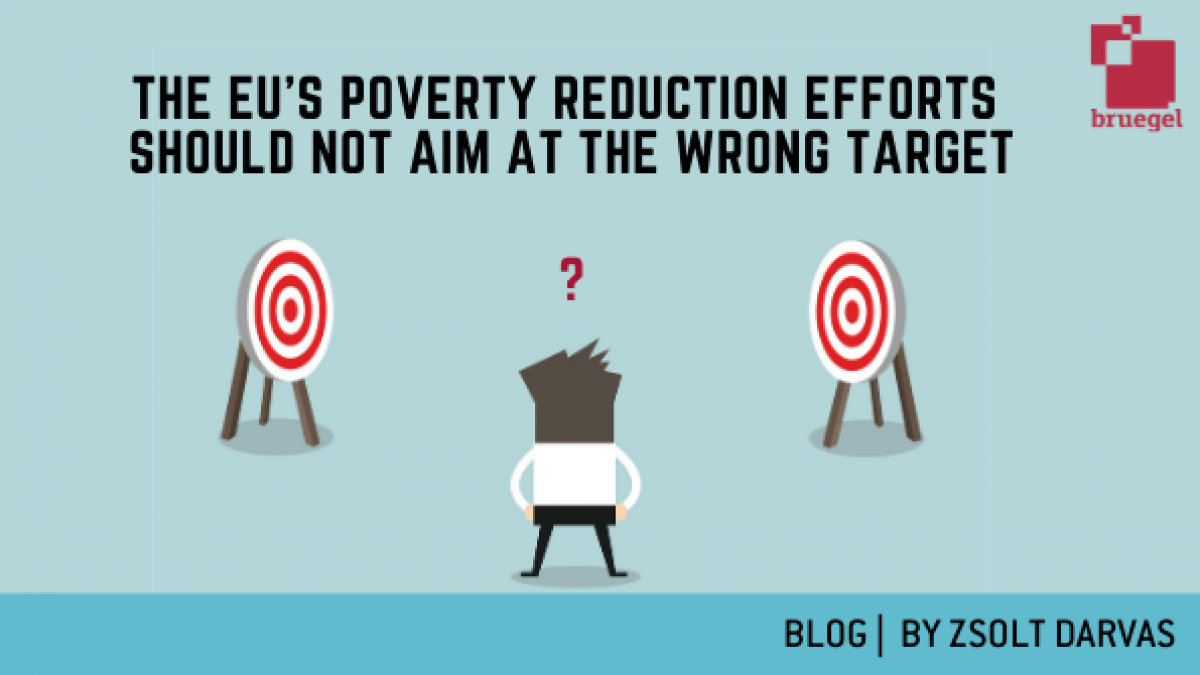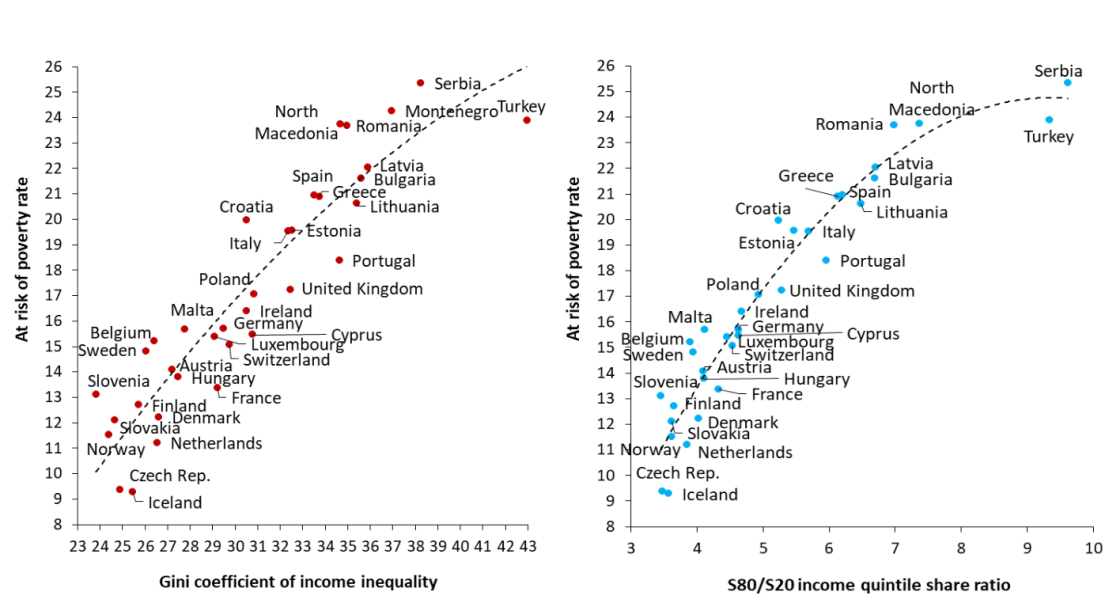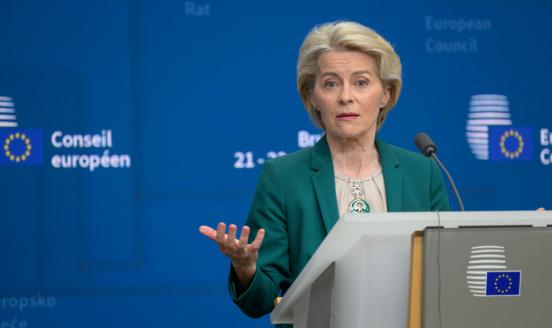The EU’s poverty reduction efforts should not aim at the wrong target
The EU cannot meet its ‘poverty’ targets, because the main indicator used to measure poverty actually measures income inequality. The use of the wrong

The European Union’s 2010 growth strategy, Europe 2020, included a target to lift “over 20 million people out of poverty” – to reduce their number from 116 million (or 24% of the EU population) to 96 million. This was to be done between 2007 and 2019 in the first 27 EU member states – including the United Kingdom, but predating Croatian membership. Europe 2020 refers to 2008-2020, but the monitoring values published by Eurostat for any particular year refer to the year of the survey, which considers income in the previous year.
Europe has a poor track record against such targets. The goal of the Europe 2020’s predecessor, the Lisbon Strategy, “to make a decisive impact on the eradication of poverty”, was missed. In fact, the number of people deemed to be poor increased by more than 7 million between 2000 and 2010 in the first 15 EU members. The increase between 2000 and 2007 was 6.4 million and therefore the global financial and economic crisis, which intensified in 2008, was not a major reason for this failure.
Progress towards the Europe 2020 poverty target has been disappointing: the number of people deemed ‘poor’ declined by 7.3 million from 2007-2017, making it unlikely that the 20 million reduction target will be achieved.
The at risk of poverty indicator measures income inequality
Why is it so hard to reach the EU’s poverty target? The main reason (as I detailed in an article in Social Indicators Research) is that the EU uses the wrong indicator. Progress was measured against an ‘at risk of poverty’ indicator in the Lisbon Strategy, which is also a core indicator for Europe 2020. But this measures income inequality, not poverty.
This indicator considers people to be at risk of poverty if their income is below 60 percent of national median income, though this does not necessarily place them at high risk of poverty. Even Eurostat’s glossary says the indicator “does not measure wealth or poverty, but low income in comparison to other residents in that country, which does not necessarily imply a low standard of living.” For example, someone with an income slightly below 60 percent of the median income in Luxembourg, and thereby regarded as ‘at risk of poverty’, can consume seven times more goods and services (measured in purchasing power standards) than someone in Romania with an income slightly above 60 percent of the national median income, who is therefore not considered to be ‘at risk of poverty’.
Income inequality and the share of people with an income below 60 percent of the national median are in principle associated. When income inequality is low, the at-risk-of-poverty rate is also low because if everybody earns roughly the same, incomes do not vary greatly from the median. This is irrespective of whether everyone is super rich or everyone is super poor.
For example, imagine an isolated tribe: everyone ‘earns’ the same (food to survive, basic cloths and a shelter), so nobody is below the median income and therefore the ‘at risk of poverty’ rate is zero, even though all tribe members are extremely poor.
In contrast, in more unequal societies there are greater income differences and therefore more people below 60% of median income.
Theoretically, it is easy to establish a clear mathematical relationship between various measures of income inequality and the ‘at-risk-of-poverty’ rate, as illustrated by Figure 1.
Empirically, Figure 2 demonstrates this relationship for 35 European countries. When their at-risk-of-poverty rates are plotted against the indicators of income inequality, the relationship is clear.
Figure 2: The empirical association between income inequality and the ‘at risk of poverty’ rate

Source: Bruegel based on Eurostat’s ‘ilc_li02’, ‘ilc_di12’ and ‘ilc_di11’ datasets. Note: The at risk of poverty indicator is ‘At risk of poverty rate (cut-off point: 60 percent of median equivalised income after social transfers)’. The Gini coefficient is the ‘Gini coefficient of equivalised disposable income’. The S80/S20 income quintile share ratio is also calculated from equivalised disposable income.
This relationship also holds within countries. Figure 3 shows that the Gini coefficient and the ‘at risk of poverty’ rate moved in tandem in a number of countries. In contrast, the severe material deprivation rate (a useful available measure of poverty in the European context) changed in strikingly different ways in some countries, highlighting again that the ‘at risk of poverty’ rate is distinct from poverty developments.
Therefore, the ‘at risk of poverty’ indicator does not measure poverty (meaning too poor to meet basic needs), but income inequality (meaning the extent to which income is distributed unevenly among a population).
At risk of poverty or social exclusion
Of course, Europe 2020’s main measure of poverty is the ‘at risk of poverty or social exclusion’ indicator, which is broader than the ‘at risk of poverty’ indicator. It is combined with indicators of the number of people living in households with very low work intensity, and of the number of people classified as ‘severely materially deprived’, meaning they are unable to afford certain basic expenses. Figure 4 breaks down this indicator into two components: those ‘at risk of poverty’ and those who are not, irrespective whether they are also severely materially deprived and/or living in a low work intensity household.
The striking message of Figure 4 is that the number of people deemed ‘at risk of poverty’ is very stable in the EU as a whole. This sounds rather counterintuitive, as it would suggest that:
- There was no poverty reduction pre-crisis (2005-2008) in the initially rather poor central and eastern European countries, despite their very rapid economic growth;
- There was no poverty increase after 2008, when GDP contracted in all EU countries (but Poland) and unemployment increased, while wages fell significantly in some countries; and
- There was no poverty reduction in the post-2013 period when economic recovery took off, unemployment declined, and wages grew by double digit percentages annually in many central European countries.
This is so counterintuitive it cannot be true. Indeed, the Gini coefficient of income inequality barely shifted in the EU in the last decade, and so neither did the ‘at risk of poverty’ indicator. On average, for the first 27 EU countries, the Gini increased from 29.8 in 2007 to 30.0 in 2017, while the average share of people deemed ‘at risk of poverty’ increased from 16.2 percent in 2007 to 16.7 percent in 2017. In terms of number of people, the increase is 3.2 million from 2007-2017, as shown by Figure 4.
In fact, the other group on Figure 4 – people who are either classified as severely materially deprived and/or living in household with low work intensity, but are not ‘at risk of poverty’ – declined between 2005 and 2008, increased from 2008 to 2012, and declined again afterwards – in line with the developments I described above.
Hopefully, there is scope for further reduction in the number of low-work and high-deprivation people. But the ‘at risk of poverty or social exclusion’ indicator is dominated by the ‘at risk of poverty’ indicator, and thus unless we see a dramatic reduction in income inequality, the share of people judged as in poverty under Europe 2020 will not change much.
Further problems
Unfortunately, there are other problems with the ‘poverty’ indicator.
That there are enormous differences between national ‘poverty’ thresholds in the EU (ie 60% of national median income). Adding up people with such different consumption levels, and expressing their total number as a share of the EU population, is pointless.
Moreover, to calculate the EU-wide ‘at risk of poverty’ statistics, Eurostat simply adds up the number of people below 60% of national median income in each country. But this calculation differs from counting the number of people in the whole EU who are below 60% of the median income in the whole EU.
The ‘at risk of poverty’ also suffers from theoretical weaknesses, as it violates four standard axioms for a poverty indicator, as set in the literature (see my article).
The use of the ‘at risk of poverty’ indicator in EU policy discussions
In EU policy circles, the ‘at risk of poverty’ indicator is typically used as an indicator measuring absolute poverty, which is inappropriate and confusing. The expression ‘poverty reduction’ is very often referred to in connection with this indicator, but I did not find any mention in EU policy documents where the clear theoretical and robust empirical associations between the ‘at risk of poverty’ indicator and various indicators of income inequality were mentioned. The European Commission’s Social Protection & Social Inclusion website continues to state that “the Europe 2020 strategy for smart, sustainable and inclusive growth sets targets to lift at least 20 million people out of poverty and social exclusion”, without defining poverty and highlighting the near equivalence of the poverty indicator and indicators of income inequality. European Parliament resolutions (for example here) and even anti-poverty organisations have referred to ‘poverty’ when in fact they are speaking about the misleading at-risk-of-poverty indicator. Clearly, there is great confusion about the interpretation of the ‘at risk of poverty’ indicator.
A new indicator is needed to monitor poverty
The Europe 2020 strategy expires this year and the European Commission and European Parliament should take the opportunity to scrap the misleading ‘at risk of poverty’ indicator and its many variants. The academic literature provides ample suggestions of proper poverty indicators. The real risk in continuing to use the ‘at risk of poverty’ indicator is that those who are really poor in Europe are not monitored and are thereby forgotten.



